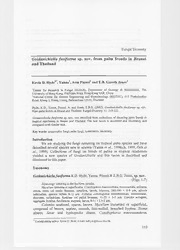Table Of ContentFungal Diversity
Goidanichiella fusiforma sp. novo from palm fronds in Brunei
and Thailand
Kevin D. Hyde1*, Yanna\ Aom Pinnoi2 and E.B. Gareth Jones2
lCentre for Research in Fungal Diversity, Department of Ecology & Biodiversity, The
University of Hong Kong, Pokfulam Road, Hong Kong SAR, China
2National Center for Genetic Engineering and Biotechnology (BIOTEC), 113 Phaholyothin
Road, Klong 1,Klong Luang, Pathumthani 12120, Thailand
Hyde, K.D., Yanna, Pinnoi, A. and Jones, E.B.G. (2002). Goidanichiella fusiforma sp. novo
from palm fronds in Brunei and Thailand. Fungal Diversity 11: 119-122.
Goidanichiella fusiforma sp. novo was identified from collections of decaying palm fronds in
tropical rainforests in Brunei and Thailand. The new taxon is described and illustrated, and
compared with similar taxa.
Key words: anamorphic fungi, palm fungi, systematics, taxonomy.
Introduction
We are studying the fungi occurring on tropical palm species and have
described several species new to science (Yanna et al., 1998a,b, 1999; Goh et
al., 1999). Collections of fungi on fronds of palms in tropical rainforests
yielded a new species of Goidanichiella and this taxon is described and
illustrated in this paper.
Taxonomy
Goidanichiellafusiforma K.D. Hyde, Yanna, Pinnoi & E.B.G. lones, sp. novo
(Figs. 1-7)
Etymology: referring to the fusiform conidia.
Mycelium immersa et superficialia. Conidiophora macronemata, mononemata, solitaria,
erecta, recta vel paulo flexuosa, simplicia, laevia, brunnea, 240-300 x 6-9 Ilm, apicem
subhyalina, apicem inflata 8-12 Ilm. Cellulae conidiogenae monoblasticae, determinatae,
discretae, cylindricae, hyalinae vel pallid brunnae, 11-23 x 2-3 Ilm. Conidia acrogena,
aggregata, hyalina, fusiformes, aseptata, laevia, 9-11 x 2.5-3 Ilm.
Colonies scattered, sparse, brown. Mycelium immersed or superficial,
composed of brown, septate, smooth, thin-walled, branched hyphae. Stoma
absent. Setae and hyphopodia absent. Conidiophores macronematous,
•Corresponding author:KevinD.Hyde;e-mail:[email protected]
119
Figs. 1-5. Goldanichiella fusiforma (from holotype). 1. A conidiophore bearing conidia on
natural substratum. 2-4. Close-up of apicalregion of conidiophores. Note penicillate branches
which bear conidiogenous cells (arrowheads) with developing conidia. 5. Hyaline, fusiform
conidia. Bars: 1= 50~m;2-5= 10 ~m.
mononematous, solitary, erect, branched at the apex forming stipe and head;
stipe straight or flexuous, swollen at the apex, smooth, cylindrical, brown to
dark brown, paler towards the apex, 240-300 x 6-9 Jlm (x = 255 x 8 Jlm,n =
25); apex forming a swollen head, 8-12 Jlm(x = 10Jlm,n =25), bears primary
branches which themselves bear secondary branches arranged penicillately
(Figs. 1, 6). Conidiogenous cells monoblastic, determinate, terminal, discrete,
cylindrical, hyaline to pale brown, borne atthe endsof secondary branches, 11
23 x 2-3 Jlm(x = 12.5 x 2.5 Jlm,n = 25) (Figs. 2-4, 6). Conidia enteroblastic,
aerogenous, solitary, aggregated in slimy heads, hyaline, fusiform, aseptate,
smooth, 9-11 x 2.5-3 Jlm(x = 9.5 x 2.8 Jlm, n = 25) (Figs. 2-5, 7). Conidial
secession schizolytic.
120
Fungal Diversity
"
:-:
( jt'
" "
".-" , ,
',,_,I" ,···.~.''..
.:.~: "
,., "'t
....
"
, "" "
..:1,'
';:,::.1
:.~;;
,, ,.
."
11," I'"
'''1.,1',I,' 'I"",
-,.'.'.
.~
..::.:,.:'
.....
..'
•....
:~~;~;:
......
..,.',...r....·.. ...'
:::::.;;
:..::~....$ Figs. 6, 7. Goldanichiel/a fusiforma
............ (from Herb. BIOTEC, AOM 0008).
..',::,:
:':..:::::•:.~ 6. Conidiophore and conidiogenous
cells.7.Hyaline,fusiformconidia.
Colonies on PDA very slow growing, attaining a diameter of 4-5 cm in 5
months at 25 C, pale brown, texture silky, flat, colouring agar pale brown;
reverse colour unchanged.
Material examined: BRUNEI, Temburong, Batu Apoi Forest Reserve, The University
of Brunei Darussalam Kuala Belalong Field Studies Centre (KBFSC), Baki Tributary, on
decaying rachis of Oncosperma horridum, Feb. 1999,YAN 60Ar [HKU(M) 13225,holotype
designated here] -livingculture inHKUCC4666,4667; ondecayingrachis ofSalacca affinis,
Feb. 1999,YAN 60 Ar [HKU(M) 13256];THAILAND, Narathiwat, Sirindhom Peat Swamp
Forest, on submerged dead petiole of Eleiodoxa conferta, 25 Sep. 2001, A. Pinnoi (Herb.
BIOTEC, AOM 0008).
Habit: Saprobic on fronds of Eleiodoxa conferta (petiole), Oncosperma
horridum (rachis) andSalacca affinis (rachis),
Known distribution: SouthEastAsia(Brunei andThailand).
Notes: Goidanichiella was reviewed by Gams et al. (1990) and a single
species G. barronii W. Gams, Steiman & Seigle-Murandi was accepted.
Goidanichiella sphaerospora Matsush. had been invalidly published and the
121
type material lost. Goidanichiella fusiforma is distinct from G. barronii in
producing relatively large, fusiform conidia (9-11 x 2.5-3 !lm).
The specimen from Thailand had larger conidiophores (205-520 !lm
long, 10-17.5 !lm diam.) with a narrower swollen head (5-7.5 !lm) and slightly
shorter conidiogenous cells (9-12 x 2.5-3 !lm) and slightly longer conidia (11
x
14 x 2-3 !lm, = 11.9 x 2.7, n = 25). As the width of the conidia and
conidiogenous cells are similar and the lengths overlap with those of the Brunei
specimens, we are of the opinion that the Thailand specimen does not require
separate species status.
Key to species of Goidanichiella
1.Conidia globose 3-4 x 2-3 /lm, or allantoid, 4-6.5(-7) x 1.4-2 /lm G. barronii
1.Conidia relatively large, fusifrom, 9-14 x 2-3 /lm G.fusiforma
Acknowledgements
We thank the Universiti of Brunei Darussalam for organising the permission to study
palm fungi in this country. The University of Hong Kong is thanked for the award of a
Postgraduate Studentship to Yanna. The Thai project is supported by BRT grant R-144012. We
thank B. Bussaban for technical assistance, P. Lumyong for laboratory facilities, S. Lumyong
for her continued support and M. Boonyanant and his staff for their assistance with field work
at Sirindhom Research and Nature Study Centre, Narathiwat.
References
Gams, W., Steiman, R. and Seigle-Murandi, F. (1990). The hyphomycete genus
Goidanichiella. Mycotaxon 38: 149-159.
Goh, T.K., Ho, W.H., Yanna and Hyde, K.D. (1999). A revision of the genus Dictyosporium
with descriptions of three new species. Fungal Diversity 2: 65-100.
Yanna, Hyde, K.D. and Goh, T.K. (1998a). Koorchaloma novojournalis sp. nov., a new
sporodochial fungus from Hong Kong. Fungal Diversity I: 193-197.
Yanna, Hyde, K.D. and Goh, T.K. (1998b). Staurophoma calami, a new coelomycete from
Hong Kong. Sydowia 50: 139-143.
Yanna, Hyde, K.D. and Goh, T.K. (1999). Endomelanconium phoenicicola sp. nov., a new
coelomycete from Phoenix hanceana in Hong Kong. Fungal Diversity 2: 199-204.
(Received 18February 2002; accepted 6 July 2002)
122

